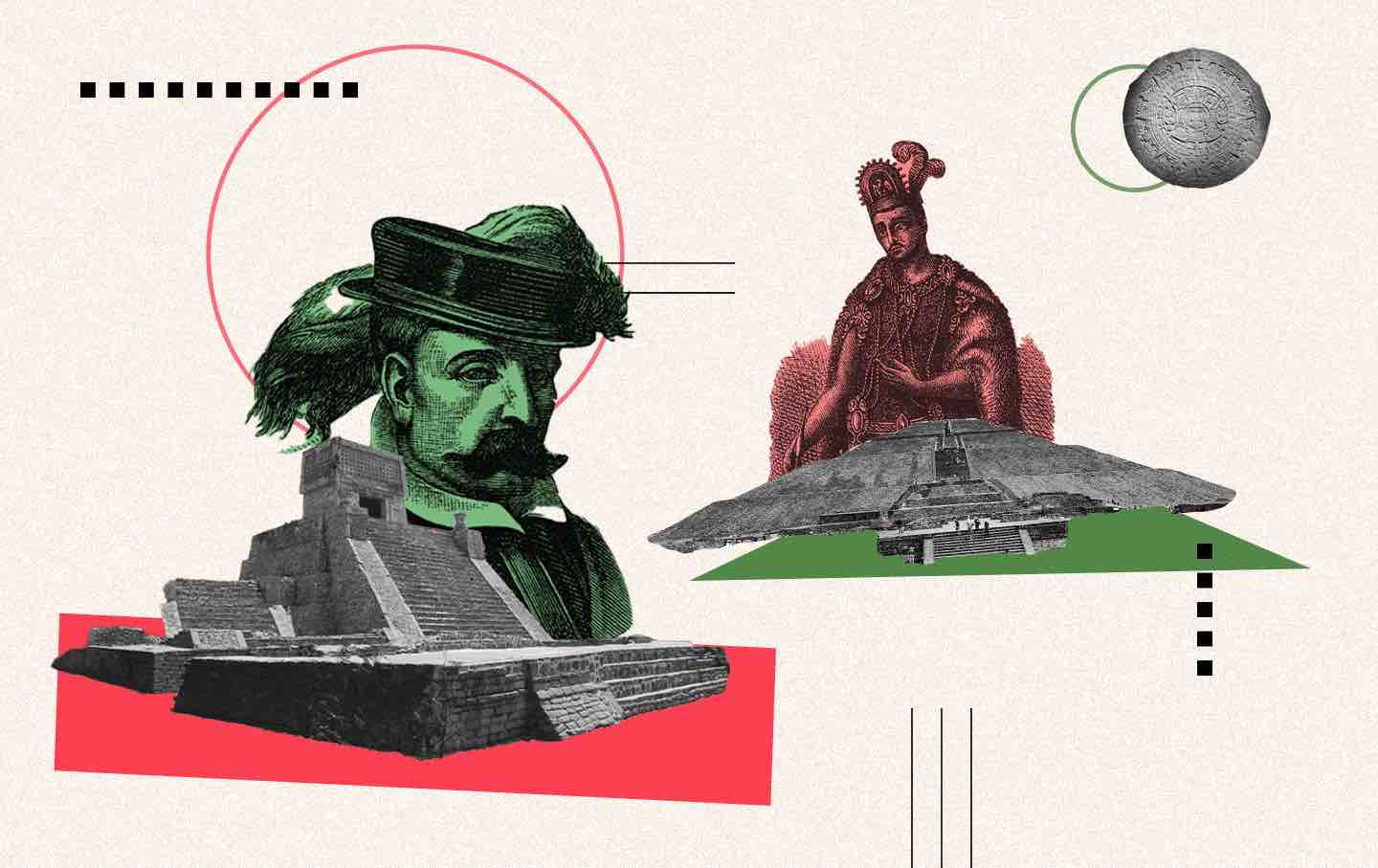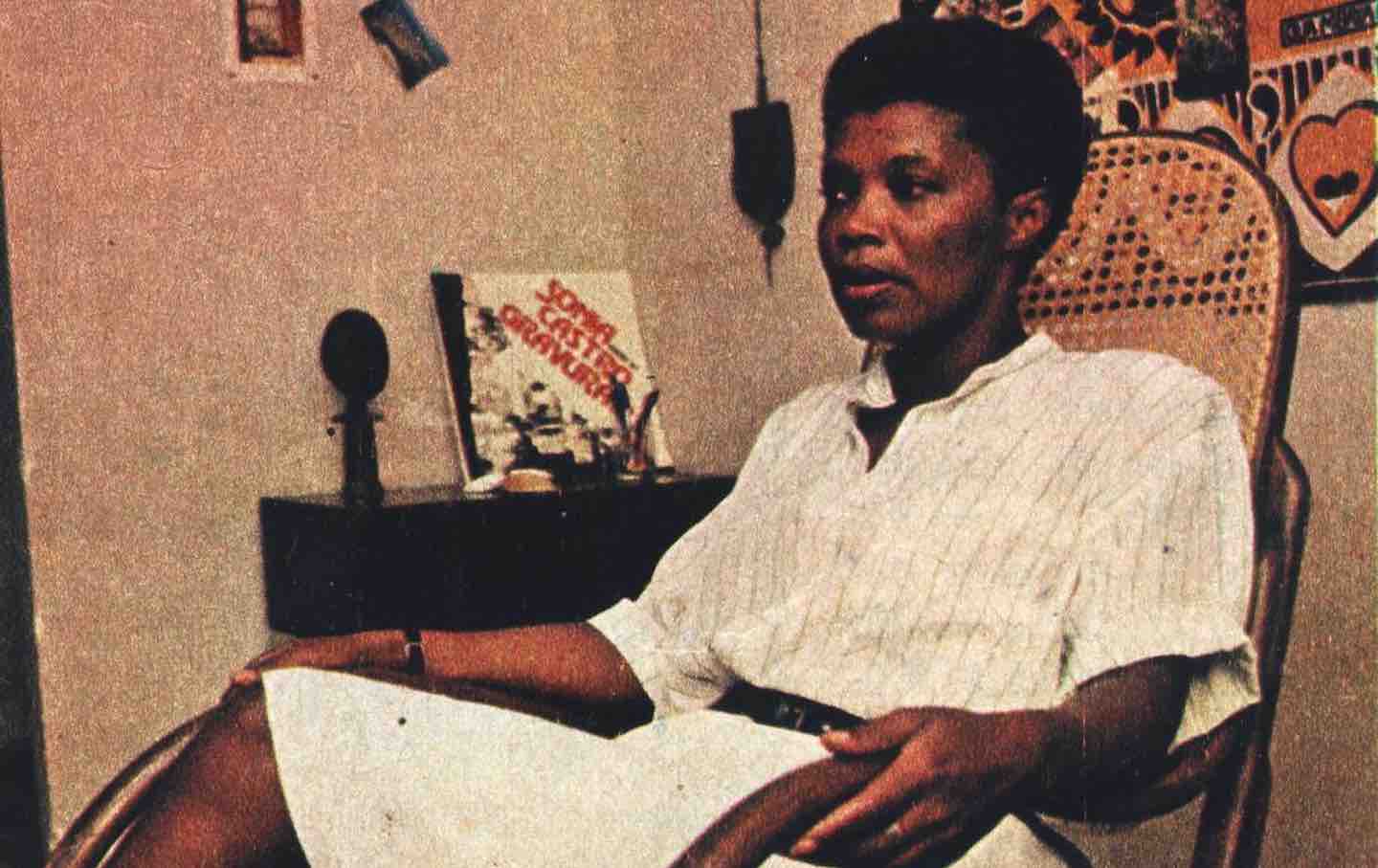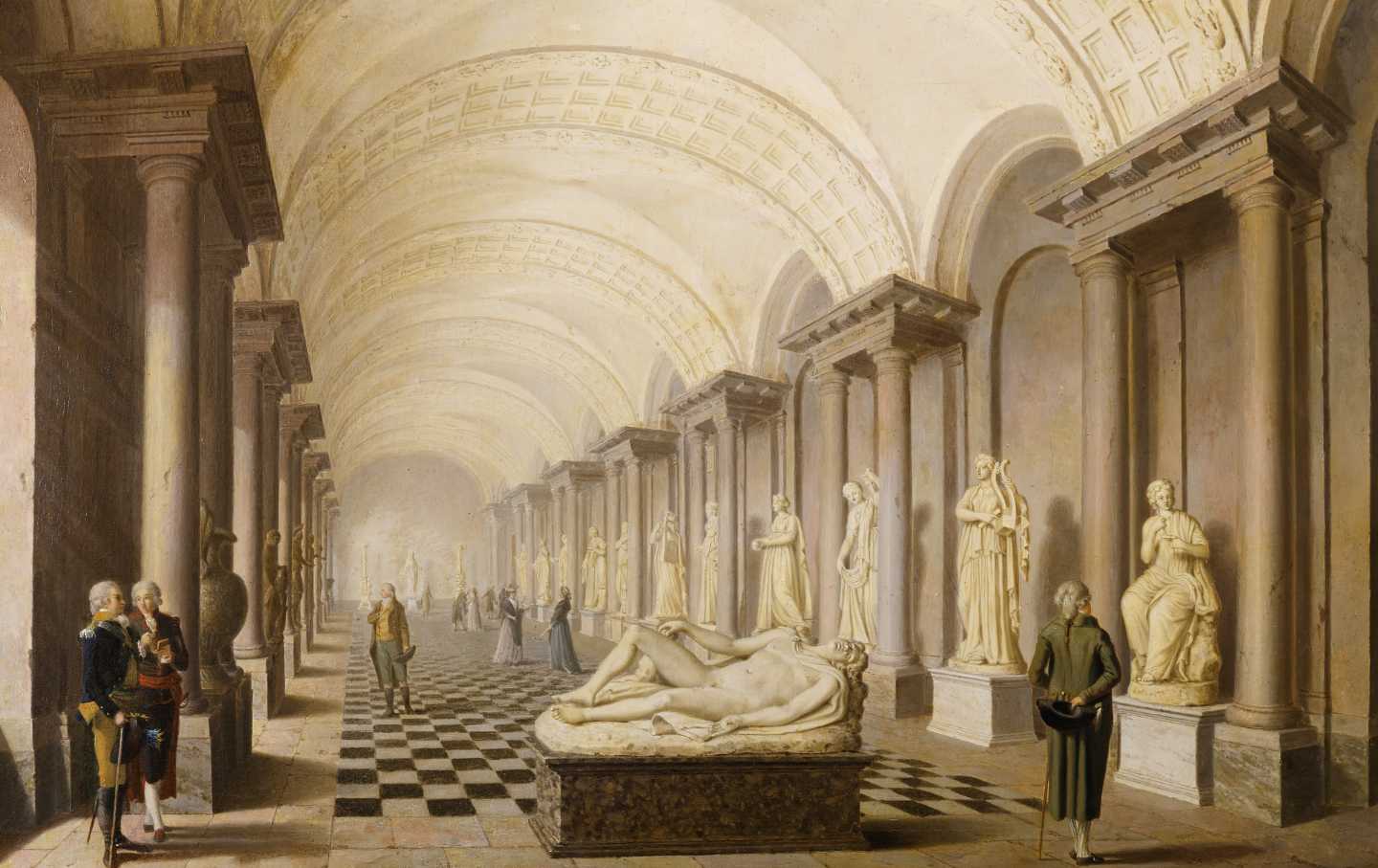The Mexican Conquest: A Story Told in the Conditional Tense
Restaging the meeting between Moctezuma and Hernán Cortés, Álvaro Enrigue’s You Dreamed of Empires explores how little we still know about this moment in history.

Clockwise from the left: An engraving of Hernan Cortés, an Aztec temple known as Santa Cecilia Acatitlan, an engraving of Moctezuma II, an Aztec Calendar found in Tenochtitlan, Mexico
(Universal Images Group / DEA / De Agostini)On November 8, 1519, a few hundred Castilian soldiers and horsemen led by Hernán Cortés entered the magnificent city of Tenochtitlan. The city, larger than most European capitals at the time, seemed to shimmer and float atop Lake Texcoco. Recording this fateful encounter in his True History of the Conquest of New Spain, Bernal Díaz del Castillo wrote that he and his fellow soldiers wondered “if what they were seeing was perhaps a dream.”
Books in review
You Dreamed of Empires
Buy this bookWe all know how this particular dream ends: Two years after their grand entrance into Tenochtitlan, Díaz and his fellow soldiers destroyed the city. By the time he sat down to write his history five decades later, Díaz was describing a society that was “overthrown and lost,” with “nothing left standing.” Today, Tenochtitlan’s remains are buried beneath the teeming streets of Mexico City.
Álvaro Enrigue’s latest novel, You Dreamed of Empires, takes place on the day of the Castilians’ arrival in the city. By depicting a moment when many outcomes were still possible—the Spanish invaders, vastly outnumbered, could easily have been killed—the novel tells a history without victors and losers. In doing so, it makes histories like Díaz’s just another story.
Enrigue has long been fascinated by the slippery relationship between history, mythmaking, and literature. Over the course of seven novels and two story collections, his fiction has playfully interrogated the way that families—and nations—construct the past through shared stories. In Spanish, historia means both “history” and “story,” and Enrigue stands in a long line of Latin American novelists whose work examines the distorting impact that these retellings can have on the present.
You Dreamed of Empires seeks to unsettle a central origin story of the Mexican nation. On the day of their fateful arrival, the Castilians—or “Caxtilteca,” as the narrator refers to them—are not yet conquerors but rather invited guests of the all-powerful Mexica ruler, Moctezuma Xocoyotzin. Suspicions abound on all sides. Moctezuma’s advisers are concerned that their leader—a habitual user of heavy-duty psychedelics who is fascinated by the Castilians’ horses—is insufficiently attuned to the threat posed by the newcomers, who have recently massacred thousands of the Mexica’s allies in nearby Cholula. The Castilians, meanwhile, fear that the arrogant and inscrutable Cortés has led them into a trap that will surely end in their slaughter at the hands of Moctezuma’s fearsome warriors.
In chapters that alternate between the Mexica and Castilian perspectives, the familiar contours of the historical record are continually interrupted—at first subtly, then with increasing stridency as the day draws to a close with a diplomatic meeting between Cortés and Moctezuma. As the narrative becomes stranger, the novel asks: Is every account of the past a work of imagination?
Born in Guadalajara in 1969 and raised in Mexico City, Enrigue made a notable debut with his first novel, La muerte de un instalador—a biting satire of the Mexican art-world elite that was published by Joaquín Moritz, the famed publishing house that established a prior generation of Mexican heavyweights, such as José Emilio Pacheco, Salvador Elizondo, and Rosario Castellanos. By his next novel, El cementerio de sillas, Enrigue had established his recurring fascination with history: Its protagonist locks himself in his Mexico City apartment in order to divine the secret history of his ancestors.
Beginning with his 2008 novel, Vidas perpendiculares—whose mute protagonist’s life story is interrupted by a cascade of seemingly disconnected capsule portraits of people from across civilizations and centuries—Enrigue blended this interest in the past with a distinctive style. His novels since then have all featured a chatty, bemused, and omniscient first-person narrator whose keen eye for irony belies his unyielding control over each story’s mechanics. This layered perspective, more intimate than third-person narration and less enveloping than first-person, puts Enrigue’s narrator in the perpetual position of an unusually charming dinner-party companion. (It is this charm, I think, that prevents one from minding too much that his characters—be they Mongolian child brides, hardscrabble north Mexican ranchers, or US Army captains—all tend to use the same slang-laden idiom.)
Though he has lived in the United States and taught at American universities since the early 2000s, Enrigue’s reputation in the Anglosphere is tied to Natasha Wimmer’s 2016 translation of his novel Muerte súbita (Sudden Death). Loosely structured around a tennis match between Caravaggio and the Spanish Golden Age poet Francisco de Quevedo, Sudden Death marked the first time that Enrigue made fiction from the lives of historical figures—including the major figures of the Spanish conquest of Mexico. Though the novel roams widely across the history of Renaissance Europe, it suggests that high European culture would be unimaginable without the forceful dispossession of Indigenous Americans.
Enrigue continued to explore this theme in his next novel, Ahora me rindo y eso es todo (2018). Structured around a western-style kidnapping plot, and interwoven with a chronicle of the narrator’s road trip to the US Southwest with his partner and their children as they await their green cards, the novel is intercut with fictionalized episodes from the lives of the final independent generation of the Chiricahua Apache—and of the Mexican and US forces who steadily pressed in on them from all sides as they both consolidated their national projects over the 19th century.
Compared with these earlier novels, You Dreamed of Empires takes place on a substantially more contained stage. Though he maintains his chatty style, Enrigue drops the braided narratives, tones down the metafictional asides, and focuses the action squarely on a single day. At first, this emphasis on “straight” historical fiction feels disorienting, even pallid. Yet Enrigue’s embrace of the genre soon makes a radical departure from the historical record. Seen in this light, You Dreamed of Empires is the culmination of a decades-long project of burrowing into the past. Rather than retelling history in his own way, Enrigue sets out to rewrite it.
Like Díaz, whose 16th-century True History was written in response to a hagiographic biography of Cortés, Enrigue’s narrator spends the first half of the book insisting on accuracy, on correcting the record. Some of these corrections are familiar in our statue-smashing age: Cortés is not a dashing, brilliant hero but rather an “ill-favored and artless son of Extremadura.” Other interventions are considerably more learned. Atotoxtli, Moctezuma’s wife, was indeed his sister, but theirs was a symbolic marriage meant to ensure imperial stability. Describing the complex web of interethnic marriage among Tenochtitlan’s nobility, the narrator wryly notes that “the English historians of the nineteenth century, who really had no clue, would call them Aztecs to solve the problem, and it stuck.”
Even the novel’s moments of pure invention contain corrections to the conventional history. Long, anxious exchanges between Atotoxtli and Tlilpotonqui, Moctezuma’s chief adviser, demolish the notion of a backwater people so awed by European weaponry that they confused their invaders for long-lost gods. Instead, the Mexica are portrayed as sophisticated political operators, full of courtliness and savvy—not to mention their fretting concern about the imperial turbulence exacerbated by the Castilians. (Atotoxtli thinks they should simply kill the newcomers and take their horses.) The Spanish, meanwhile, are portrayed as more or less stumbling into the pages of history, of “making things up as they went along, with extraordinary results.”
Collectively, all of this revisionism has the effect of blurring the boundary between “history” and “fiction.” (Did Moctezuma really eat “trout wrapped in papalo leaves in a pumpkin seed sauce” on the day the Spanish arrived in his city?) The narrator’s declamatory sentences ring with the kind of truth that comes from immersing oneself in the revisionist histories on the Conquest that have been produced in the last 50 years. (Enrigue thanks many historians in the book’s acknowledgments.) The narrator’s voice is one of authority, and it becomes easy to settle into the story he’s telling.
Yet the tidiness and familiarity of this narrative is brought to a juddering halt two-thirds of the way through the novel. Jazmín Caldera, a plantation owner, investor, and “third in command” on the Castilian mission, wanders off into the city, and the narration suddenly swerves into the conditional tense. “If Jazmín Caldera had existed,” the narrator repeats, again and again, as he describes what Caldera might have seen in the city. Suddenly, everything in the novel—even the cast of characters with which Enrigue begins the book—is called into question.
At this point, the humbled reader might turn to Wikipedia and Google or an old paperback copy of Díaz’s True History to figure out which of the novel’s characters really existed and which didn’t. But it soon becomes clear that this would be a fool’s errand.
On his way out of the city, Caldera walks by the huey tzompantli, an enormous tower of skulls placed on a platform in the middle of the huge temple complex that took up much of central Tenochtitlan. Turning to Google, a reader will see that a full archaeological understanding of the huey tzompantli was only reached in 2017: For centuries, historians, assuming the structure had disappeared forever, relied on inaccurate descriptions drawn from the early Spanish chroniclers. By having his made-up character walk past a place that was lost to the past for so long, Enrigue insists on a simple yet profound point: The Mexica world spread far beyond what the Spanish chroniclers were able to transcribe.
Truly grasping the significance of something like the huey tzompantli, in other words, requires both careful study and acts of imagination. All writers, even those writing histories, must create characters—real or made-up—as stand-ins for our limited understanding. All history is stories, all the way down.
Popular
“swipe left below to view more authors”Swipe →Perhaps the most infamous figure of the Mexican conquest is Malinalli, a Nahua princess “given” to Cortés by her Maya enslavers shortly after his arrival in the Yucatan. (Known by many names, she’s most commonly referred to as “La Malinche” outside the pages of this novel.) Malinalli translated for Cortés during the Conquest and eventually bore him at least one son, making her an object of fascination and scorn in popular histories.
Enrigue has made Malinalli into a fictionalized character once before, in Sudden Death. In that earlier novel, Enrigue attempted to rescue her from her historical fate by casting her as a canny figure who uses Cortés as a means to get revenge on the society that placed her into slavery. Sudden Death also depicted their relationship as one of, if not love, then at least passionate entanglement. In You Dreamed of Empires, though, Enrigue rewrites their relationship in far harsher terms. Shortly after their arrival, Cortés rapes Malinalli. “Content in his triumph,” the narrator acidly observes, Cortés falls asleep and dreams of Jesus.
The next time Cortés has a dream in the novel, it’s under the influence of a powerful psychedelic. (After Moctezuma offers him the drug, one of Cortés’s men expresses caution. But taking her revenge, Malinalli shushes him: “Let him see how it feels to be fucked in the ass.”) During his trip, Cortés has a series of visions depicting his life up until “that very morning.” He goes to bed, and after he wakes up, the narration suddenly starts to move at a rapid clip, covering the two years between the Castilians’ arrival and the fall of Tenochtitlan, then the establishment of colonial Mexico, then the rest of the last 400 years of Mexican history—a history that culminates with “this book and you reading it.” And then Cortés wakes up, again.
The novel’s final scene returns to the room where Cortés and Moctezuma took the drug and offers a departure from the historical record that manages to be both predictable and a little shocking. Reading the ending, I was reminded of an earlier scene when Moctezuma consults his high priest on whether he should attack the Castilians or not—the other priests, interpreting their calendars, have said that it’s not an auspicious time. “There are many possible futures,” the priest reports: “Our calendars are shit but they’re the best we’ve got.”
In an essay about Bernal Díaz del Castillo, the Mexican writer Carlos Fuentes recalls walking across Mexico City’s enormous Zócalo—the site of Tenochtitlan’s temple complex—as a law student. “Images of both cities, ancient and modern, dissolved back and forth before my eyes,” Fuentes writes.
Novelists, he goes on to say, “must imagine the past so that the future, when it happens, can also be remembered, avoiding the death of the eternally forgotten.” This inversion strikes me as a helpful précis for much of Enrigue’s work, and this book in particular. Enrigue’s reimagination of the past proposes that we suspend our attachment to the familiar story—the one that always ends the same way, with Indigenous desolation and European triumph—and make room for new ones in the future.
More from The Nation

The Harrowing Ardor of Heather Lewis The Harrowing Ardor of Heather Lewis
Her fiction was miscast as merely transgressive. Rather, her novels were interested in understanding life in its most unvarnished and unmediated.

What the Paiva Family Means to Brazil What the Paiva Family Means to Brazil
In I’m Still Here, one Brazilian clan’s confrontation with the military dictatorship dramatizes the last half-century of Brazil’s democratic travails.

Beatriz Nascimento’s Histories of Afro-Brazilian Rebellion Beatriz Nascimento’s Histories of Afro-Brazilian Rebellion
The scholar, poet, and filmmaker devoted her life to sketching out a revisionist historiography of resistance in Latin America but also the world.

The Real Problem With Trump’s Cheesy Neoclassical Building Fetish The Real Problem With Trump’s Cheesy Neoclassical Building Fetish
Sure, it’s a dog whistle for “retvrn” types and the results are tacky—but that’s not the worst part.

“The Pitt” and the Gritty Return of the Hospital Drama “The Pitt” and the Gritty Return of the Hospital Drama
In the frenzied medical drama, the limits and problems of the healthcare system serve as the basis for the show’s plot.

The Uncomfortable Genius of Mike Leigh The Uncomfortable Genius of Mike Leigh
In “Hard Truths,” Leigh reminds us that a family dinner can tell the story of a whole society.


